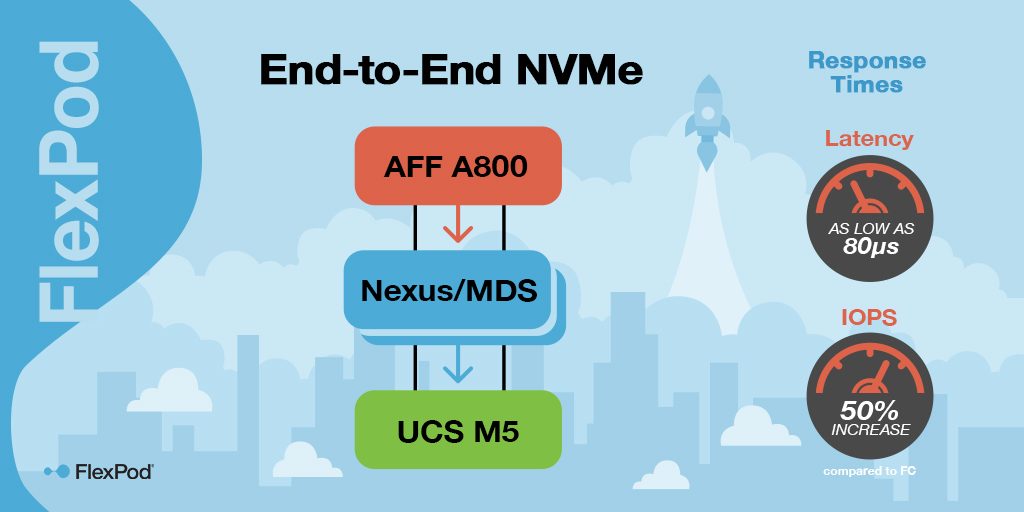End-to-End NVMe for FlexPod: Your Three Biggest Questions Answered


Natalia Eichinger
For the past 9 years, we’ve made it our mission to help businesses and institutions all over the world to be efficient, support their clients, and promote successful outcomes. How do we do that? By simplifying and modernizing IT through continuous innovation.
Now, the mission continues onward with our latest innovation: end-to-end NVMe for FlexPod®.
Already emerging as a core technology, NVMe (NVM Express) is a new data storage standard. It’s capable of transforming enterprise data storage access and transport by delivering very high bandwidth and very low latency storage access for current and future memory solutions.
And the FlexPod solution is the ideal platform for bringing it to your organization. That’s because end-to-end NVMe for FlexPod enables you to handle the scalability requirements of next-generation, mission-critical applications, such as artificial intelligence, machine learning, deep learning, and real-time analytics.
To find out how, watch Solutions Architect Michael Hommer’s video explainer.
https://www.youtube.com/watch?v=2ao0txUP5Hs
Let’s walk through the main points in the video one by one.
1. How does NVMe fit into the next evolution of storage?
Until recently, storage solutions were essentially mechanical systems in which ones and zeros—the binary units of your information—were recorded onto magnetic disks known as spinning platters. Although these systems worked, they required you to put in a lot of time and effort to ensure the integrity of your information.
These days you probably use solid-state drives (SSDs) instead of spinning platters. Of course, the goal here is the same: to store your information. The critical difference is how you get there. This is where NVMe enters the picture. With NVMe, a technology built specifically to take advantage of modern architectures, you’re able to streamline the process of ensuring data integrity.
2. What can end-to-end NVMe for FlexPod do?
End-to-end NVMe for FlexPod can do two things for you: dramatically reduce response times and boost application performance.
Research shows that with a spinning platter setup, you can expect a response time of about 100 milliseconds or more across the entire stack. But when you’ve got NVMe talking to the SSD, that response time can drop to as low as 80 microseconds. Amazing, right? That adds up to a huge boost in performance for your applications. And from an IOPS perspective, our testing shows that NVMe enables a 50% increase in your performance over straight fibre channels.
But to get both benefits, you have to maintain communication throughout your entire stack. End-to-end NVMe for FlexPod can help with that.

3. How does FlexPod help you take full advantage of NVMe?
To take full advantage of NVMe, you need an architecture that allows you to maintain the NVMe protocol from end to end. That’s just what FlexPod does. It establishes a complete end-to-end path of NVMe, from the storage to the compute layer and across the network between the two.
It starts with the NetApp® AFF A800 array, a system designed to maintain the NVMe protocol from the disks through shelf backplanes and up to and even exiting the controller. Of course, your applications don’t run on storage—they run across the network on the compute layer. So, the next step is to bridge the gaps with Fabrics. FlexPod achieves this by using NVMe over Fibre Channel, connecting the AFF A800 to the latest generation of Cisco MDS switches and Cisco UCS M5 servers.
The results: You get a full, end-to-end path of NVMe and all the transformative benefits that come with it.
Do you want to learn more about end-to-end NVMe for FlexPod? Check out our white paper or contact us directly.
For the latest FlexPod updates, make sure to keep visiting the blog.
Natalia Eichinger
Natalia Eichinger is a senior product marketing manager for the NetApp StorageGRID object storage solution. Before joining NetApp in 2018, Natalia worked at Microsoft, performing various roles in marketing, working with technical audiences, and looking after the Enterprise Mobility and Security product portfolio.